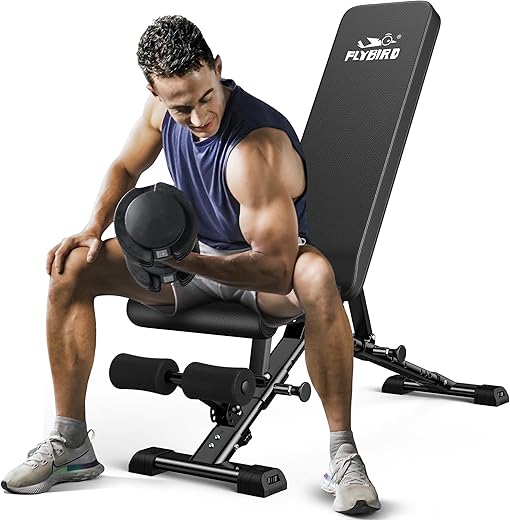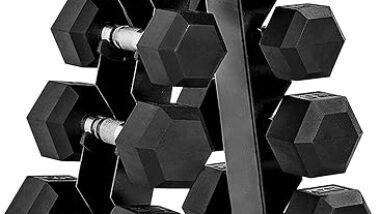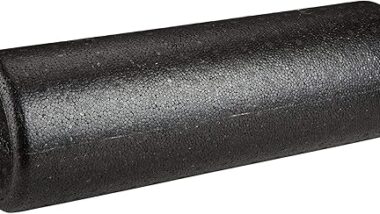When it comes to strength training, I know firsthand how frustrating it can be to struggle with improper equipment adjustments. An adjustable weight bench is a game changer, but if it’s not set up correctly, it can lead to ineffective workouts or even injury. I’ve been there, trying to make the most of my exercise routine, only to realize that my bench was not properly aligned for the exercises I wanted to perform. In this post, I want to share some essential tips on how to adjust your weight bench for different exercises. Together, we’ll ensure that you can maximize your workout efficiency and enhance your overall performance, all while prioritizing your safety and comfort. Let’s dive in!
Understanding Your Weight Bench
When it comes to strength training, a weight bench is an essential piece of equipment that can enhance your workouts significantly. Understanding the different types of weight benches available and their respective features will help you make an informed decision that best suits your fitness goals. Below, we delve into the specifics of flat, incline, decline, and adjustable benches, along with practical examples and key considerations to keep in mind.
Types of Weight Benches
Flat Benches
Flat benches are the most straightforward type of weight bench, designed to provide a stable and level surface for a variety of exercises. They are primarily used for flat bench presses and other traditional strength training movements.
Key Features:
- Fixed position; no adjustable angles
- Ideal for weightlifting exercises like bench presses, flyes, and tricep extensions
- Generally more affordable and space-efficient
Product Example:
- CAP Barbell Flat Bench: This bench is made of high-density foam and has a sturdy steel frame, making it a reliable choice for beginners. It typically retails for around $70.
Incline Benches
Incline benches are set at a specific angle, usually between 15 to 30 degrees, to target the upper chest and shoulders more effectively. This incline position is beneficial for exercises like the incline bench press and shoulder press.
Key Features:
- Adjustable angles for varied workouts
- Targets different muscle groups compared to flat benches
- Enhances muscle definition in the upper chest
Product Example:
- Bowflex 5.1S Stowable Bench: This incline bench offers 6 adjustable settings, allowing you to switch between flat, incline, and decline positions. It retails for approximately $299 but is a versatile addition to any home gym.
Decline Benches
Decline benches are designed to have a downward slope, which emphasizes the lower part of the chest during exercises. These benches are less common but can be highly effective for specific workouts.
Key Features:
- Focuses on the lower chest and abdominal workouts
- Ideal for decline bench presses and sit-ups
- Often combines with adjustable features for more versatility
Product Example:
- Marcy Adjustable Utility Bench: This product includes a decline feature in addition to flat and incline positions, making it versatile for a range of exercises. It usually costs around $120.
Adjustable Benches
Adjustable benches combine the features of flat, incline, and decline benches, providing the greatest versatility for various strength training exercises. Understanding how to adjust these benches is crucial for maximizing your workouts and ensuring safety.
Benefits of Adjustable Benches
- Versatility: Allows for a wide range of exercises targeting different muscle groups.
- Space-Saving: Eliminates the need for multiple benches, making it ideal for small home gyms.
- Customization: You can set the bench to your preferred angle, enhancing comfort and effectiveness.
Features to Consider
When looking for an adjustable bench, consider the following features:
- Weight Capacity: Ensure the bench can support your weight along with the weights you plan to lift.
- Padding: Look for high-density foam padding for comfort during workouts.
- Stability: A sturdy frame is essential for safety during heavy lifting.
Product Example:
- Fitness Reality 1000 Super Max Weight Bench: This adjustable bench has a weight capacity of 800 lbs and offers 12 adjustable backrest positions. It typically sells for around $129 and is well-reviewed for its stability and comfort.
Practical Adjustments for Exercises
Understanding how to properly adjust your bench can enhance your workouts significantly. Here are some practical examples:
- Bench Press: Set the bench to a flat position for traditional bench pressing. Ensure your feet are flat on the ground and your back is firmly against the bench.
- Incline Dumbbell Press: Adjust your bench to a 30-degree incline. This modification targets the upper chest more effectively, allowing for better muscle activation.
- Decline Sit-Ups: Set your bench to a decline position for sit-ups. Secure your feet, and make sure to engage your core to avoid straining your back.
By understanding the different types of weight benches and their features, you can choose the right equipment to meet your fitness needs. Investing in the right bench will not only enhance your workouts but also ensure you get the most out of your strength training regimen.
Setting Up for Bench Press Exercises
When it comes to bench press exercises, proper setup is crucial for maximizing your performance and minimizing the risk of injury. Whether you’re doing the flat bench press, incline bench press, or decline bench press, adjusting your weight bench correctly can make a significant difference in your workout experience. Here’s how to set up for each type of bench press, along with safety precautions and tips for achieving the best form.
Flat Bench Press Setup
The flat bench press is a staple exercise for building chest strength. To properly set up your bench for this exercise, follow these guidelines:
Adjusting the Bench Angle
- Keep the bench flat: Ensure that the bench is set to a horizontal position, typically 0 degrees. Most adjustable benches, like the Body-Solid GFID225 or the Bowflex 5.1S, allow for easy adjustments.
Safety Precautions
- Use a spotter: Always have a workout partner or spotter when using heavy weights. This adds a layer of safety in case you struggle with the lift.
- Secure weights properly: Use collars on the barbell to prevent weights from sliding off during the lift.
Tips for Form
- Feet flat on the floor: Keep your feet planted firmly on the ground to maintain stability.
- Wrist position: Keep your wrists straight and aligned with your forearms to avoid strain.
- Elbow angle: Maintain a 45-degree angle between your elbows and your body to reduce shoulder stress.
Incline Bench Press Setup
The incline bench press targets the upper chest and shoulders more than the flat press. Here’s how to set it up:
Adjusting the Bench Angle
- Set the bench between 30 and 45 degrees: This angle effectively targets the upper pectoral muscles. Models like the Rogue adjustable bench or Titan Fitness adjustable bench allow for precise angle adjustments.
Safety Precautions
- Stabilize your body: Ensure your back is firmly against the bench to avoid arching and potential strain.
- Use a lighter weight: When first attempting the incline press, start with a lighter load to ensure that you can maintain proper form.
Tips for Form
- Grip width: A wider grip can help engage the chest more, while a narrower grip targets the triceps.
- Shoulder blades retracted: Keep your shoulder blades squeezed together to promote stability.
Decline Bench Press Setup
The decline bench press focuses on the lower chest. Follow these steps to set up your bench properly:
Adjusting the Bench Angle
- Set the bench to a decline angle of about 15-30 degrees: Make sure the decline is not too steep, or you risk losing control. Equipment like the Fitness Reality 1000 Super Max or the Marcy Adjustable Olympic Bench includes decline settings for easy adjustments.
Safety Precautions
- Secure your feet: Ensure that your feet are secured if your bench has foot pads, as this will prevent you from sliding down during the lift.
- Use a spotter: As with the other variations, having a spotter is crucial for safety when lifting heavier weights.
Tips for Form
- Lower the bar slowly: Control the descent of the barbell to avoid injury.
- Keep elbows tucked: Tucking your elbows in closer to your body can reduce shoulder strain and promote better engagement of the lower chest.
Key Points to Remember
| Bench Press Type | Optimal Angle | Key Safety Precautions | Form Tips |
|---|---|---|---|
| Flat Bench Press | 0 degrees | Use a spotter, secure weights | Feet flat, wrist aligned |
| Incline Bench Press | 30-45 degrees | Stabilize back, start lighter | Grip width, shoulder blades retracted |
| Decline Bench Press | 15-30 degrees | Secure feet, use a spotter | Lower bar slowly, elbows tucked |
By following these adjustments, safety precautions, and form tips for your bench press exercises, you can enhance your workout effectiveness and ensure a safer lifting environment. Always remember to listen to your body, progress at your own pace, and seek guidance if you’re unsure about your technique or setup.
Final Tips for Optimal Performance and Safety
In conclusion, properly adjusting your weight bench is essential for enhancing your workout performance and minimizing the risk of injury. By familiarizing yourself with the mechanics and guidelines specific to each exercise, you can optimize your training results. I encourage you to make these adjustments a regular part of your routine and continuously assess your form to ensure a safe and effective workout experience.






I tried adjusting my bench according to your tips, and I finally hit a new PR on bench press! Thanks for the guidance!
That’s awesome to hear! Congrats on your PR! Consistent adjustments can make a huge difference, glad you found it helpful!
I’d love to see an article on adjusting the bench for incline and decline exercises! Those techniques seem tricky to master.
Lower back pain can often come from arching your back too much during bench presses. Make sure your feet are flat on the ground and your shoulder blades are retracted. You might also want to try a bench with better lumbar support!
I’ve heard people say that a flat bench isn’t always the best option for everyone. What’s your take on that? Is it better to have multiple bench options?
Great point! While the flat bench is a staple, having adjustable benches can definitely help target different muscle groups more effectively. It’s all about what feels best for your body!
I remember when I first started bench pressing, I used to set my bench too high. It caused me so many problems. Learning to adjust properly was a game-changer!
It’s so easy to overlook the little things when starting out. Glad you figured it out! Proper setup really does transform your workout experience.
Any recommendations for a budget-friendly weight bench? I’m just starting out and don’t want to break the bank!
If you’re looking for something affordable, the CAP Barbell Adjustable Weight Bench is a solid choice and won’t empty your wallet!
Can you explain the importance of grip width during bench pressing? I’ve heard differing opinions on this.
Great question! Grip width can affect the muscle groups you target. A wider grip generally focuses more on the chest, while a narrower grip engages the triceps more. Experiment to see what works best for you!
Great article! Can you recommend any other resources for mastering different bench techniques? I’m looking to expand my knowledge.
Absolutely! Check out ‘The Bench Press: A Complete Guide’ by Eric Cressey. It covers various techniques and tips for different body types!
What about safety tips when benching alone? I’ve seen some horror stories about accidents.
Good call! Always use a spotter if you can, but if you’re lifting alone, consider using safety arms or a power rack. Better safe than sorry!
I always struggle with lower back pain when doing bench presses. Any tips for adjusting my form or bench setup to alleviate this?
I think the debate about whether to lift with a flat or slightly inclined bench is ongoing. What do you think is the more efficient method?
It really depends on your goals! A flat bench is great for overall chest development, while an incline bench can target the upper chest better. Both have their merits!